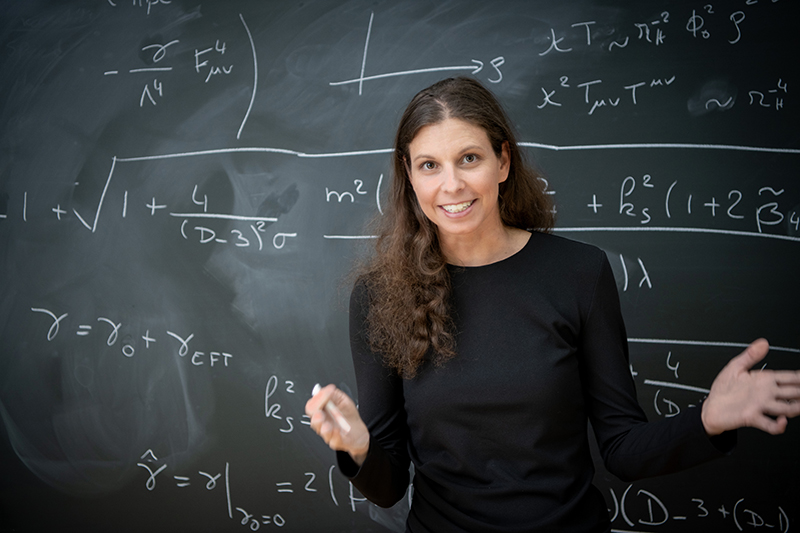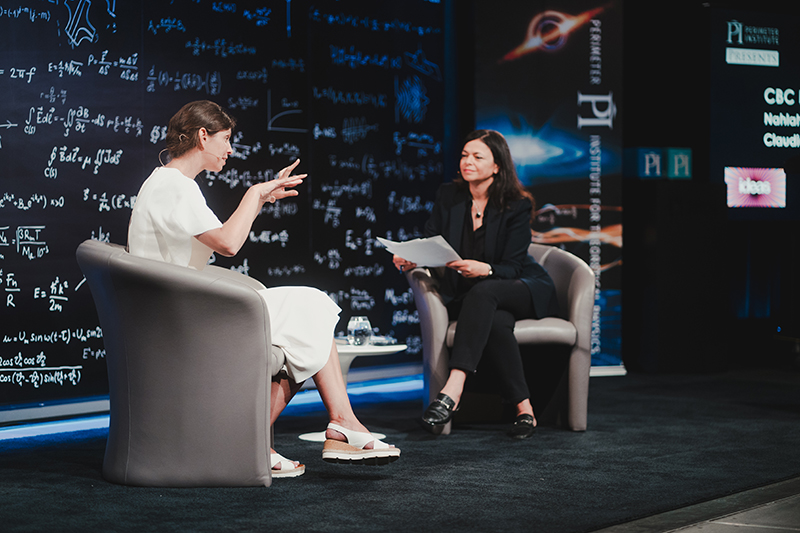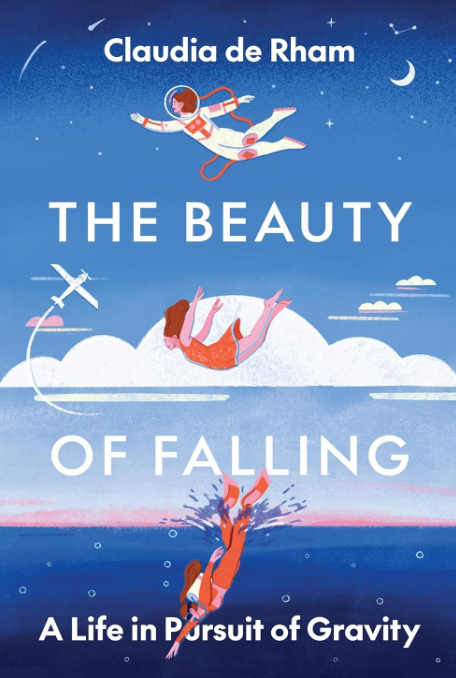An eight-month-old baby pulls herself up by grasping the edge of a coffee table, falls on her behind, giggles, and tries again. She has also taken to throwing her plastic toy down on the floor, only to have a parent pick it up, so she can throw it down again.
This child is experimenting with a fundamental force of nature: gravity, the force that is most apparent to us from the moment we are born.
Claudia de Rham is no longer a child, but she never stopped experimenting with it.
The former Perimeter Institute postdoctoral researcher has taken up flying airplanes, scuba diving, and horse jumping. She was even an astronaut candidate for the European Space Agency at one point in her life. Now, she is a theoretical physicist at Imperial College in London and a Visiting Fellow at Perimeter.
All throughout, she has been doing research into the force of gravity.
This spring, she released a popular book about her personal and professional experiences with gravity — The Beauty of Falling: A Life in Pursuit of Gravity. Most recently, during her visit to Perimeter, de Rham was interviewed by Nahlah Ayed, host of CBC’s Ideas.
She spoke of embracing the complete freedom and the blissfulness of falling into gravity, be it into the skies above the Earth or diving into the oceans. But she has also grappled with the pain that can come with falling, in one’s life and work.
Gravity is the constant that connects us as humans, and it connects us to the universe, de Rham says. “It is the seed from which everything is derived, and I need to understand it at the deepest possible level.”
The strange thing about gravity is that it is a weak force, compared to the atomic-level forces of nature, she says.
It is far weaker than the force that holds atomic nuclei together. Yet it is the force that we are constantly challenging. “We are dominated by the experience of gravity here, because we are so close to this hugely massive object,” she says.
The need to understand the cosmos and gravity led de Rham into her postdoctoral cosmology research at Perimeter where she was part of a group of scientists who pioneered the modern version of massive gravity, a gravitational model that might help explain the accelerated expansion of the universe.
Massive gravity essentially modifies Einstein’s theory of general relativity.
In Einstein’s gravity picture, gravity is mediated by a particle, which we call the graviton and would be massless, like the photon. According to Einstein’s theory of general relativity, gravity would be a force that would have an infinite reach, so it could reach all the way to the furthest edges of the cosmos.
We also know that the universe is not only expanding but is doing so at an accelerated rate. The most natural explanation for the accelerated expansion of the universe is that it is pushed by the energy of the vacuum. What we call the “vacuum” of space is not actually empty. It is seething with virtual particles that carry energy.
The problem is that we would expect this vacuum energy to result in a much too fast acceleration of the universe. According to Einstein’s theory of gravity, if gravitons are massless and the same all the way across the entire cosmos, then the huge amount of vacuum energy would cause the expansion of the universe to accelerate at a rate which would be way too fast.
One solution is to instead postulate some other, unknown, “dark energy” force pushing the universe apart at an accelerated rate. But this solution ignores the vacuum energy problem.
In the theory of massive gravity, the dark energy would not be needed, because the graviton would have a mass. Giving gravitons a mass would mean that reach of gravity, as we know it, would be finite and would be weaker at very long-distance cosmological scales. That would mean that even though the vacuum energy is large, its effect on the evolution of the universe is much weaker and this would naturally lead to a more reasonable rate of acceleration in the expansion of the universe.
The theory of massive gravity was first conceptualized in the 1930s, but it ran into some serious mathematical problems. In a landmark paper in 2011, de Rham with her collaborators, Gregory Gabadadze, and Andrew J. Tolley, made a breakthrough by constructing a more sophisticated mathematical framework for the theory of massive gravity, avoiding the problems of previous versions.
Their constrained version of vacuum energy with massive gravitons could naturally cause accelerated expansion without dark energy, and it would happen at the just-right rate that we observe. It avoids the problem of too-fast acceleration in the previous version of a vacuum energy with massless gravitons.
Like all good science, there is a way to test the theory and find out if it is right or wrong. If there are massive gravitons, then low-frequency gravitational waves will travel slightly slower than high-frequency ones. Although the difference would be exceedingly small, new astronomical observatories such as Pulsar Timing Arrays, and the Laser Interferometer Space Antenna (LISA) mission, will be able to detect gravitational waves at lower frequencies, which would enable scientists to find this evidence. Also, the Simons Observatory will be looking for primordial perturbations and deviations from the cosmological constant in the cosmic microwave background.
All of gravity research builds on the results of the previous giants of scientific exploration, de Rham says.
Newton theory of gravity is still perfectly correct in some regimes and excellent at describing the way objects fall to our Earth, but the corrections provided by Einstein’s general relativity made it more useful in describing gravity in a wider variety of scales.
It could still be that further corrections beyond Einstein will be needed in the larger cosmos. In the future, there will likely be another theory of gravity, but that will not make Newton or Einstein wrong. “We are building layers of knowledge. We move from one layer to another, that does not make any layer wrong. We just keep going deeper,” de Rham says.
At Perimeter, where de Rham often returns as a Visiting Fellow, she experiences “a vibrant atmosphere” where exploration of an unusual theory of gravity becomes possible in place where collaboration and independence of thought is encouraged. “It’s like being in a big family where we gather to be part of a solution and to make progress in understanding nature as a whole,” she says.
Her theory could be right, or it could be wrong for what it was originally intended. If it is wrong, that would be disappointing, and yet, that is also part of scientific exploration, and we would still have learned a great deal. There is something to be achieved in failure as well — for the scientific explorer, the journey is what counts, de Rham says.
“It is not so much about fitting in the box and trying to achieve something for the sake of a particular model that you are using to describe a specific phenomenon, but it is very much about uncovering the possibilities,” she says.
On a personal level, de Rham is no stranger to disappointment. She was in the European Space Agency’s astronaut training program, hoping to experience weightlessness in space. She almost made it. She passed the initial medical exams and tests and was on the shortlist.
But then, at the very last stage, she was disqualified for a medical reason she previously had not known about. One of the last tests showed she had latent tuberculosis, which meant that at some point in her life travels, she had been infected with TB, but was not aware of it. Her body’s antibodies had fought it off. Unfortunately, that disqualified her from the program. “It was just a risk they had no reason to want to take,” she says. But de Rham says she is still happy that she did the training and got as far as she did.
She has had many other adventures in gravity. While she was a postdoctoral researcher at Perimeter, she learned to fly. She would rent an airplane at the Region of Waterloo International Airport and would fly over the Perimeter building. She also loves scuba diving and horse jumping.
“It’s all part of embracing the experience,” she says. “It’s part of connecting with the elements; it’s part of the adventure, and understanding the balance, where you know that you will be OK if you follow the correct procedure, but there is also this level of creativity and intuition that allows you to explore a novel environment.”
She says she wrote the book to share her experience and excitement in the exploration of gravity.
“It was important to share my human experience on this journey,” she says. That journey is sometimes difficult, she adds. That is why the book is called The Beauty of Falling. “There can be a lot of pain involved, in anything we do, but we do it because deep down inside, there is that passion.”
In that sense, we are all explorers, she adds. “We should try to simply push ourselves in this exploration, because who knows where it will bring us?”
About PI
Perimeter Institute is the world’s largest research hub devoted to theoretical physics. The independent Institute was founded in 1999 to foster breakthroughs in the fundamental understanding of our universe, from the smallest particles to the entire cosmos. Research at Perimeter is motivated by the understanding that fundamental science advances human knowledge and catalyzes innovation, and that today’s theoretical physics is tomorrow’s technology. Located in the Region of Waterloo, the not-for-profit Institute is a unique public-private endeavour, including the Governments of Ontario and Canada, that enables cutting-edge research, trains the next generation of scientific pioneers, and shares the power of physics through award-winning educational outreach and public engagement.



